
This write -chronicles a Sea Grant agent’s first attempt at smoking fish. Did it go perfectly? No. Did it end up tasting great? Yes. Did he learn something about smoking? Also yes. Follow me on my fish smoking journey to learn from my successes but also from my mix-ups, which resulted in some great tips. Overall, it was a fun experience and I picked up a new skill. The tastiness of the final product as well as the challenge and technical aspects of smoking fish will have me doing it again. Pick up some fresh Florida seafood and try your hand at it today!
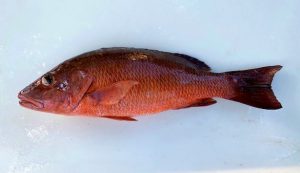
I recently came back from a fishing trip and due to COVID-19 and social distancing, was unable to have my friends and family help me enjoy my catch. As a result, I wanted to research smoking fish as a food preservation method. Smoking meat has been a preservation technique dating back to the cavemen. The combination of heat, dehydration and chemical interactions from both the brine mixture and the wood smoke can reduce microbial activity that is responsible for spoiling.
Due to many variables that can occur in a home setting, it’s difficult to give a hard and fast rule on whether home-smoked fish increases shelf life and should be treated like fresh-cooked fish. Some variables that can affect shelf life include: amount of salt in the brine, pH of the solution, cooking time/temperature, level of desiccation and cleanliness of both the environment and packaging. Additional information on the food safety of smoked products can be found here and here. Even if home smoking does not increase shelf life, it can be a fun way new way of preparing fish and has led me to consume seafood more often.
A step by step video of my experience smoking mangrove snapper can be found here. The information below details some of what I learned and provides information on the smoking process.
Background:

Salting and smoking meat is one of the oldest methods of food preservation and was a common way to avoid food spoilage. With the advent of refrigeration and chemical preservatives smoking took the back burner but is now on the rise with the increased demand for naturally prepared foods. Because of refrigeration, most smoked products now have lower salt content and more moisture as smoking has become more of a cooking method and less frequently used for preservation.
There are two methods of smoking fish, cold smoking and hot smoking. Cold smoking uses indirect heat and smoke to dry and add flavor to the fish at lower temperatures (< 90 °F). This process usually takes longer than hot smoking and the meat is never fully cooked but instead dried. Cold smoking should be done by the pros as the meats are exposed to microbe-loving temperatures for an extended period of time. Hot smoking methods are more commonly used in the U.S. as the products are considered cooked and usually occurs between 175-200 °F
The Fish:
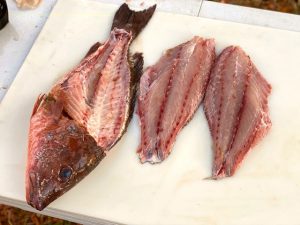
Fish species with higher fat content like salmon, mackerel, and tuna are more often used in smoked fish recipes as fats better absorb the smoke and can result in a more favorable texture. I used mangrove snapper for my recipe and have had zero complaints so don’t let that deter you! Many fishermen, myself included, freeze fish in packs too large to eat in one sitting and smoking may be an alternative method of preparing excess amounts of thawed fillets. Be sure to clean the fish thoroughly and try to portion pieces in similar thicknesses and size to make sure the brine is reacting with meat evenly. After your brine soak, remove the fish from the brine, pat the fillets fry with paper towels and organize your fish on your greased racks and let them sit for approximately an hour to let a pellicle form on the fillet. The pellicle is a thin film of protein that allows the smoke to adhere better to cured meats. Be sure to do this in a cool dry place and away from bugs!
The Brine:
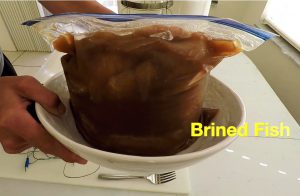
Salt reduces the moisture content in smoked foods which aids in food preservation. Read more on how is inhibits microbial growth here. In a home setting it may be difficult to know the exact level of salt/desiccation of your product making refrigeration essential! Dry salting methods can be used for smoking however brine solutions are more widely used as they are more likely to expose the entire fillet to the salt. Traditional brine recipes and methods used for preservation have higher salt content with less sit time to minimize microbial growth. Most brine recipes you find today have lower salt content and involve longer soak times as they are primarily used to enhance flavor of the product and less for preservation.
For my brine I modified an existing recipe I found on the web and there are tons out there. I mixed 4 cups of warm water with 1 cup soy sauce, ¾ cup brown sugar, ¼ cup of salt and 1 tablespoon of granulated garlic powder. The mixture was whisked to make sure all the sugar and salt thoroughly dissolved. This amount of brine was good for 4-5 pounds of fish fillets. Once my brine cooled I poured it in a gallon Ziplock bag containing my cleaned and portioned fillets. Pro tip: Use a mixing bowl with a spout or ladle the brine into the Ziplock bag, I spilled a bit of mine on the floor using a regular bowl. Make sure that you massage the bag some to get all the surfaces of the fillets exposed to the brine solution. Place the brined fillets in the refrigerator for a minimum of 6 hours. I let mine sit for approximately 18 hours as I brined them at night and intended to smoke them the next day.
The Wood:
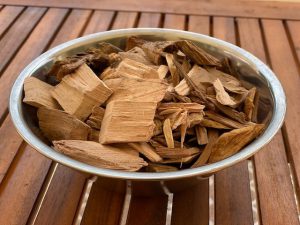
Many tree species are used to smoke meats. Some common smoking woods include oak, hickory, maple, mesquite, pecan, apple, alder and cherry. Wood blends and flavor-infused products are also available for unique taste profiles. Wood chips are currently the most common way to introduce the smoke however pellets and bricks are gaining traction as they burn slower and their compact size allows one to pack the wood container more densely which reduces the rate of replacement. For fish it is recommended to use mild woods like apple, cherry or alder to prevent overpowering the flavor of the meat. For my mangrove snapper I chose apple wood chips for my smoke.
Before placing your fish in the smoker, preheat your woodchips in the smoker for 30 minutes to 1 hour depending on the temperature of your unit. The warmer the smoker the quicker the wood will begin to smoke therefore some people will raise the temperature of their unit to get the smoke going and then reduce the temperature to ideal smoking temps prior to adding the fish. You may need to repack your woodchip container as the chips will eventually become embers and stop smoking. When refilling your wood chip container be sure to leave some embers in there to speed up the ignition of the new chips. For reference, my smoker chip container holds about 2 handfuls of chips and had to be repacked about 3 times during an approximately ~ 3-hour smoking process.
I also created aluminum bowl full of chips to place in my smoker for added smoke (I learned this trick from here). The bowl worked very well providing additional smoke for the better part of an hour, however I left it open instead of sealed which allowed moisture from the fish to drip into the bowl and suppressed the chips from smoking. In the future I will repeat this process but fully seal the container. The aluminum bowl also provided me an additional benefit that I was not aware of until I placed it in the smoker and observed the temperature, I will expand upon in this next section. I also lined the bottom of my unit with aluminum foil which made clean up a breeze.
Smoking:
Before we talk about the process, I want to mention one of the greatest tools I used during this experience which were WiFi meat thermometers. Ideally, you will want 2 temperature probes, one to gauge the internal temp of your smoker and the other in the thickest part of the fillet to read internal temperatures ensuring the fish is properly cooked. The fish should be heated to an internal temperature of at least 145 °F for at least 30 minutes to be considered safe to eat. If possible, you should shoot for an internal smoker temperature of 175-200 °F to smoke your fish.

This low temperature was difficult for me to achieve in my grill/smoker hybrid but I was able to sustain ~220 °F for the majority of the cook time by reducing the amount of air intake to the grill. When I placed the aluminum woodchip bowl that I mentioned in the previous section, I coincidentally obstructed the air intake on the bottom of the smoker allowing me to achieve those lower desired temperatures. When I opened the lid to check the fish, air would rush in and raise the temperature, so avoid opening the lid the best you can if you’re anticipating having the same challenge maintaining low temperatures. Another reason to avoid opening the smoker is that this will let the smoke escape the unit. You want the smoke interacting with the fish as much as possible to get that great smoky taste!
The thermometers also have a feature that allow me to set temperature alarms. This was very helpful when trying to achieve that ideal temp. I set a temperature alarm for 250 °F and if the smoker was getting to hot, I would be alerted and adjust the amount of propane feeding my flames. At a temperature of 220 °F my fish reached the target internal temperature of 145 °F in about 1.5 hours. However in that short amount of time, the smoky flavor wasn’t very strong so I left my fish in the smoker to be smoked further. Before starting the smoking process I read many smoker aficionados recommend about 30 minutes of smoke exposure per pound of fish, I listened to that advice and I was able to get great flavor.
Storage:

If you aren’t planning on eating your fish right away, store your smoked fish in a refrigerator or a freezer. Wrapping your fish in a breathable material like paper towels or a cloth before putting it in a container can help maintain freshness by reducing wet spots caused by condensation. Shelf life of smoked fish in the fridge should be treated like fresh cooked fish, which can be a couple of days.
Typical refrigerator temperatures for anaerobically packed fish may not be low enough to halt growth of Clostridium botulinum.Fish stored in vacuum or reduced oxygen packaging needs to be frozen as some bacteria like Clostridium botulinum prefer low oxygen environments. Smoked fish stores great in a freezer because of the reduced amount of moisture found in the product.
Conclusion:
By no means am I an expert at smoking fish but I had a great time doing it with awesome results. I hate reheating seafood, and this was a great way to have a fish snack that tasted great, still had great texture and was readily available in my fridge for a few days. I also made some killer smoked fish dip in two different styles so let me know if you would like a write up on that! Check to see if your local seafood markets are still operating and start smoking some fresh Florida fish today!
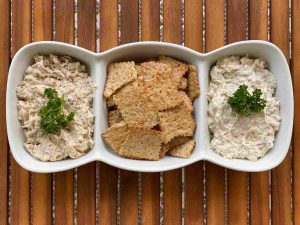
References and additional reading material:
https://edis.ifas.ufl.edu/pdffiles/FS/FS11100.pdf
https://pubs.extension.wsu.edu/smoking-fish-at-home-safely
http://www.fao.org/3/x5953e/x5953e01.htm
https://nchfp.uga.edu/publications/nchfp/lit_rev/cure_smoke_cure.html
https://seafood.oregonstate.edu/sites/agscid7/files/snic/smoked-fish-part-iii-virginia-tech.pdf
https://www.grapesandgrains.org/2017/07/the-ancient-art-and-history-of-smoked-food.html
https://www.canr.msu.edu/news/smoking_as_a_food_cooking_method
 0
0
